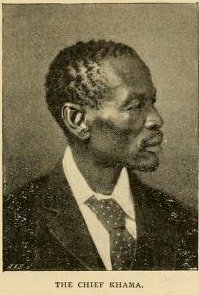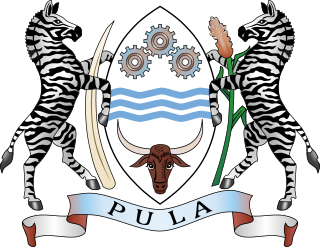Related Research Articles
The history of Botswana encompasses the region's ancient and tribal history, its colonisation as the Bechuanaland Protectorate, and the present-day Republic of Botswana. The first modern humans to inhabit Botswana were the San people, and agriculture first developed approximately 2,300 years ago. The first Bantu peoples arrived c. 200 CE, and the first Tswana people arrived about 200 years later. The Tswana people split into various tribes over the following thousand years as migrations within the region continued, culminating in the Difaqane in the late 18th century. European contact first occurred in 1816, which led to the Christianization of the region.

Khama III, referred to by missionaries as Khama the Good also called Khama the Great, was the Kgosi of the Bangwato people.

Sir Seretse Goitsebeng Maphiri Khama, GCB, KBE was a Botswana politician who served as the first President of Botswana, a post he held from 1966 to his death in 1980.

The Bechuanaland Protectorate was a protectorate established on 31 March 1885 in Southern Africa by the United Kingdom. It became the Republic of Botswana on 30 September 1966.

The Ntlo ya Dikgosi in Botswana is an advisory body to the country's parliament.
The Bamangwato is one of the eight "principal" Tswana chieftaincies of Botswana. They ruled over a majority Bakalanga population, with minorities including the Basarwa, Birwa and Tswapong. The modern Bamangwato formed in the Central District, with its main town and capital at Serowe. The paramount chief, a hereditary position, occupies one of the fifteen places in Ntlo ya Dikgosi, the national House of Chiefs.
Shoshong is a town in Botswana, formerly the chief settlement of the eastern Bamangwato.

Gaborone was a kgosi (King) of the Tlokwa, a tribe of the larger Tswana people in what is now Botswana. He became the tribe's King around 1880, after the death of his father, and secured the Tlokwa's status as the "smallest independent tribal unit" in the Bechuanaland Protectorate. He gave his name to the city of Gaborone, Botswana's current capital.
The Independence Day of Botswana, commonly called Boipuso in Setswana, is a national holiday observed in Botswana on September 30 of every year. The date celebrates Botswana's Declaration of Independence from the United Kingdom on September 30, 1966.

Bathoen I was a kgosi of the Ngwaketse people (1889-1910). Together with Khama III and Sebele I he is credited with saving the young British Bechuanaland Protectorate, a predecessor of Botswana, from being absorbed by expansionist forces in the 1890s.

Semane Setlhoko Khama (1881–1937) was a mohumagadi of the BaNgwato Kingdom in the Bechuanaland Protectorate. Educated in a missionary school, she became a teacher and upon her marriage to Khama III continued to press for education for the BaNgwato. A proponent of modern medicine, she was influential in bringing modern midwifery to the area. As a devout Christian, she encouraged women's involvement in the church and the Woman's Christian Temperance Union.

Batswana nationality law is regulated by the 1966 Constitution of Botswana, as amended; the Citizenship Act 1998, and its revisions; and international agreements entered into by the government of Botswana. These laws determine who is, or is eligible to be, a national of Botswana. The legal means to acquire nationality, formal legal membership in a nation, differ from the domestic relationship of rights and obligations between a national and the nation, known as citizenship. The Botswana nationality is typically obtained on the principle of jus sanguinis, i.e. by birth to parents with Botswana nationality. It can be granted to persons who have lived in the country for a specific period of time, who have performed distinguished service to the nation or who have an affiliation to the country through naturalisation.
The following lists events that happened during the 1960s in Botswana, beginning with its independence on 30 September 1966.
References
- 1 2 3 4 5 6 7 8 9 10 11 12 13 14 15 16 17 18 19 20 21 22 23 24 25 26 27 28 29 30 31 32 33 34 35 36 37 38 39 40 41 42 43 44 45 46 47 48 49 50 51 52 53 54 55 56 57 58 59 60 61 62 63 64 65 66 67 68 69 70 71 72 73 74 75 76 77 78 79 80 81 82 83 84 85 86 87 88 89 90 91 92 93 94 95 96 97 98 99 100 101 102 103 104 105 106 107 108 109 110 111 112 113 114 115 116 117 118 119 120 121 122 123 124 125 126 127 128 129 130 131 132 133 134 135 136 137 138 139 140 141 142 143 144 145 146 147 148 149 150 151 152 153 154 155 156 157 158 159 160 161 162 163 164 165 166 167 168 169 170 171 172 173 174 175 176 177 178 179 180 181 182 183 184 185 186 187 188 189 190 191 192 193 194 195 196 197 Morton, Barry; Ramsay, Jeff (2018). Historical Dictionary of Botswana (5th ed.). Rowman & Littlefield. ISBN 978-1-5381-1133-8.
- 1 2 3 4 5 6 7 8 9 10 11 12 13 14 15 16 17 18 19 20 21 22 23 24 25 Mwakikagile, Godfrey (2009). Botswana Since Independence. New Africa Press. ISBN 978-0-9802587-8-3.
- 1 2 3 4 5 6 7 8 9 10 11 12 13 14 15 16 17 18 19 "Botswana profile - Timeline". BBC News. 2017-09-20. Retrieved 2023-09-17.
- 1 2 3 4 5 6 7 8 9 10 11 12 13 14 15 16 Leith, J. Clark (2005). Why Botswana Prospered . McGill-Queen's Press - MQUP. doi:10.1515/9780773572416. ISBN 978-0-7735-7241-6.
- 1 2 Simon, Re; Kwadiba, Mto; King, Jg; Moidaki, M (2012). "A History of Botswana's Seismic Network". Botswana Notes and Records. 44: 184–192. ISSN 0525-5090. JSTOR 43855570.
- 1 2 3 Holm, John D.; Molutsi, Patrick P. (1992). "State-Society Relations in Botswana: Beginning Liberalization". In Hydén, Göran; Bratton, Michael (eds.). Governance and Politics in Africa . L. Rienner. pp. 75–95. doi:10.1515/9781685853297. ISBN 978-1-55587-285-4.